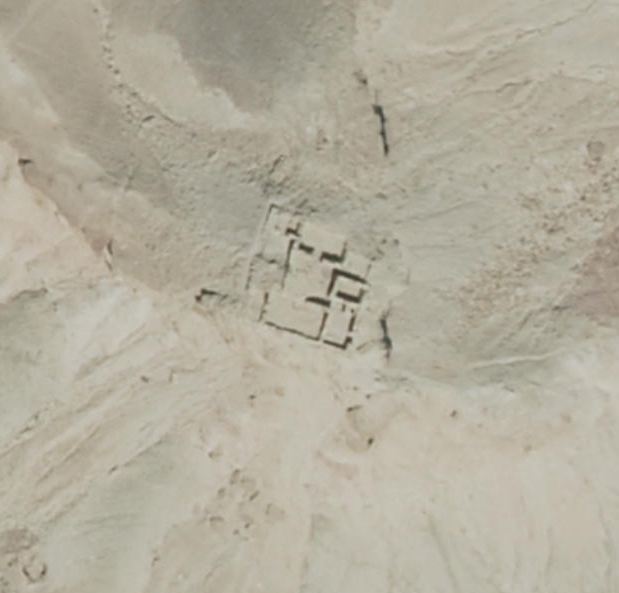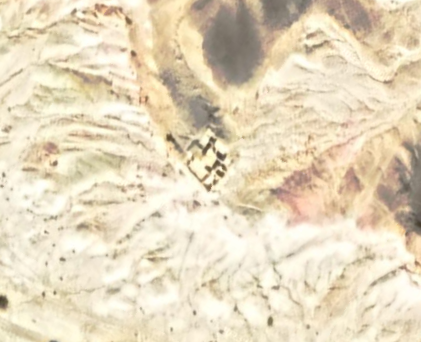Ein Rahel
| Transliterated Name | Source | Name |
|---|---|---|
| Ein Rahel | Hebrew | |
| Mezad 'En Rahel | Hebrew |
Korzhenkov and Erickson-Gini (2003) report that the fort at Ein Rahel was first constructed and occupied in the 3rd century BCE followed by a hiatus in occupation from ~100 BCE until the early first century CE after which it was re-occupied. The fort was then, according to the authors, re-abandoned in the early second century CE. The abandonment came after the fort's destruction due to what the authors beleive was a seismic event.
A site (map reference 1663.0046) on a prominent hill north of 'En Rahel in the Arabah was surveyed in 1980 by a team under D. Nahlieli, as part of the Negev Emergency Survey. In 1981, a salvage excavation was carried out here by Nahlieli and Y. Israel, on behalf of the Israel Department of Antiquities and Museums. Their excavations revealed a square structure (16 by 16m) with eight rooms around a central courtyard. The walls, of hewn limestone, were probably plastered; they survive to a height of about 2 m. The entrance was through the southeastern room, which contained a plastered installation. At least two levels of occupation were identified in some of the rooms. The earlier one was probably built toward the end of the first century BCE, the later one in the late first century CE. In addition to its rich assemblage of pottery, the site produced considerable organic material mats, baskets, shells of almonds and nuts, pomegranates, and olive and date pits. Among the artifacts found were combs, carved game pieces, a small wooden goblet, cloth remnants, and pieces of leather. Particularly notable were two camel bones bearing black-ink inscriptions in Nabatean script
- Fig. 1 - Map of the main
Hellenistic, Roman, and Byzantine sites in the Negev Hills from Stern et. al. (1993 v.3)

 Map of the main Hellenistic, Roman, and Byzantine sites in the Negev Hills.
Map of the main Hellenistic, Roman, and Byzantine sites in the Negev Hills.
Stern et. al. (1993 v.3)
- Fig. 1 - Map of the main
Hellenistic, Roman, and Byzantine sites in the Negev Hills from Stern et. al. (1993 v.3)

 Map of the main Hellenistic, Roman, and Byzantine sites in the Negev Hills.
Map of the main Hellenistic, Roman, and Byzantine sites in the Negev Hills.
Stern et. al. (1993 v.3)
- Fig. 5 - Plan of the Fort
with marked types of deformations from Korzhenkov and Erickson-Gini (2003)

 Figure 5
Figure 5
Ein Rahel
Plan of the fort with marked types of deformations.
Following Shamir (1999)
Korzhenkov and Erickson-Gini (2003) - Plan 1 - Plan of the Fort
from Shamir (1999)

 Plan 1
Plan 1
Plan of the fort at 'En Rahel
Shamir (1999)
- Fig. 5 - Plan of the Fort
with marked types of deformations from Korzhenkov and Erickson-Gini (2003)

 Figure 5
Figure 5
Ein Rahel
Plan of the fort with marked types of deformations.
Following Shamir (1999)
Korzhenkov and Erickson-Gini (2003) - Plan 1 - Plan of the Fort
from Shamir (1999)

 Plan 1
Plan 1
Plan of the fort at 'En Rahel
Shamir (1999)
Korzhenkov and Erickson-Gini (2003) describe archeoseismic evidence for an early second century CE earthquake as follows:
In the surrounding casemate rooms the latest occupational phase (dating to the early 2nd cent. A.D.) was sealed by the collapse of the upper floor of the fort. Sections excavated in these rooms revealed clear collapse of the ceiling of the lower floor and the upper floor debris sealed by the upper floor roof. The ceiling and roof of the structure were made from woven organic matting and mud and were supported by wooden beams.Shamir (1999:92) examined the textiles, basketry and cordage and reported that
A rich ceramic assemblage was discovered in the fort as well as extensive organic finds and included reed-matting and wooden beams, almond shells, nuts and olive and dates stones. Several wooden lice combs and other wooden objects were found in excellent condition, as well as many shreds of textiles and leather. Two camel bones were found bearing inscriptions in black ink in the Nabataean script.
Preserved by the arid climate, the perishables from `En Rahel include about 300 textile and basketry fragments, cordage, spindle whorls and needles. The Early Roman date of the material, provided by its archaeological context, differs slightly from its radiocarbon dating (Carmi and Segal 1995:55).1The description of the Calendaric Age distribution reported in Carmi and Segal (1995:55) which is referenced in Footnote 1 above is a bit different and earlier. See the table below from Carmi and Segal (1995:55).Footnotes1 In the fall of 1991, a brown goat-hair textile fragment from L13, Basket 129 was submitted to I. Carmi and D. Segal at the 14C laboratory of the Weizmann Institute of Science, in order to verify the archaeological conclusions. Their results suggest the fabric was manufactured in the Roman period:
Sample d14C d13C yrs BP* Calendaric Age** RT-1596 -209.2 ± 3.9 -15.95 1885 ± 40 82-204 CE * Conventional radiocarbon years before 1950.
** Calculated using CALIB 3 (Stuiver and Reimer 1993).
| Sample | d14C | d13C | yrs BP* | Calendaric Age** |
|---|---|---|---|---|
| RT-1596 | -209.2 ± 3.9 | -15.95 | 1885 ± 40 | 66-145 CE (87%), 165-186 CE (13%) |
** Calculated using CALIB 3 (Stuiver and Reimer 1993).
| Seismic Effect | Plan | Figure(s) | Comments |
|---|---|---|---|
| Tilted Walls | Rooms 9, 11, 12, and 13
 Figure 5
Figure 5Ein Rahel Plan of the fort with marked types of deformations. Following Shamir (1999) Korzhenkov and Erickson-Gini (2003) |
8

 Figure 8
Figure 8Ein Rahel Eastward tilt of eastern external wall. Strike azimuth of the wall is 16° Korzhenkov and Erickson-Gini (2003) |
Earthquake events that have occurred in other parts of the world have produced a large number of structural elements that were found to be preferentially inclined toward the epicenter. However, in some cases the inclination was in the opposing direction. Similar destruction features were found in the ancient fort at Ein Rahel where preferentially inclined walls were observed (see Fig. 5 - Plan).- Korzhenkov and Erickson-Gini (2003) |
| Oriented collapse of door lintels Eastward in Room 10 Southward in Room 20 |
Rooms 10 and 20
 Figure 5
Figure 5Ein Rahel Plan of the fort with marked types of deformations. Following Shamir (1999) Korzhenkov and Erickson-Gini (2003) |
9a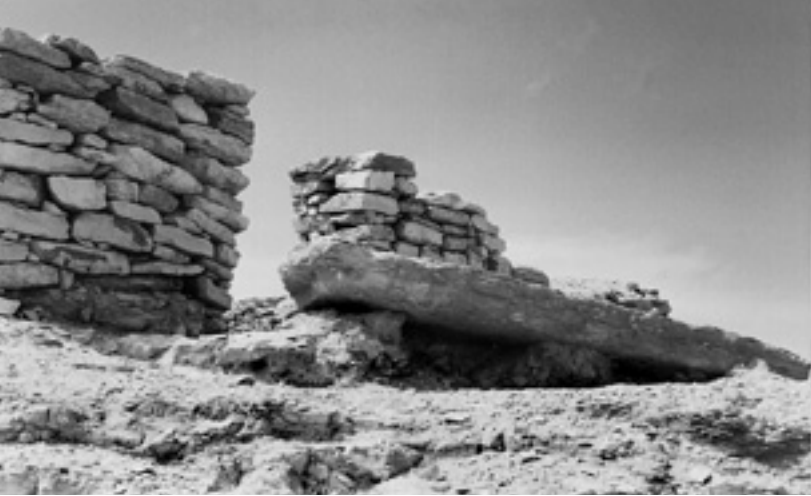
 Figure 9a
Figure 9aEin Rahel Oriented collapse of door lintel for NS- trending wall (strike azimuth is 16°–18°) Korzhenkov and Erickson-Gini (2003) 9b 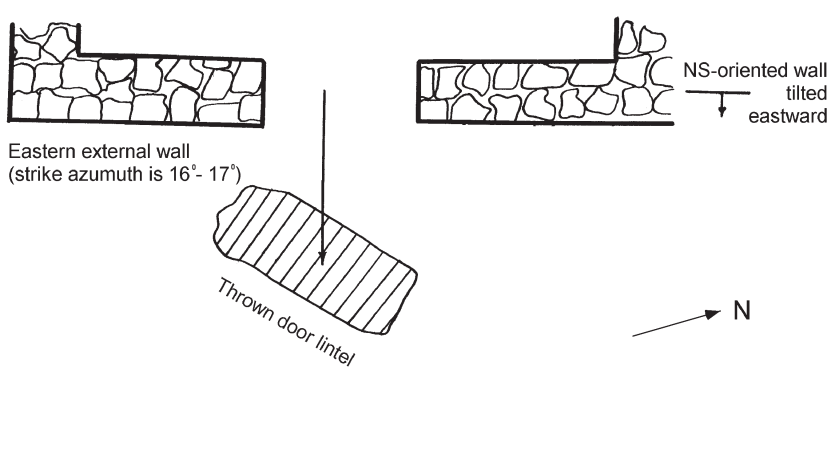
 Figure 9a
Figure 9aEin Rahel Schematic picture of Oriented collapse of door lintel Korzhenkov and Erickson-Gini (2003) 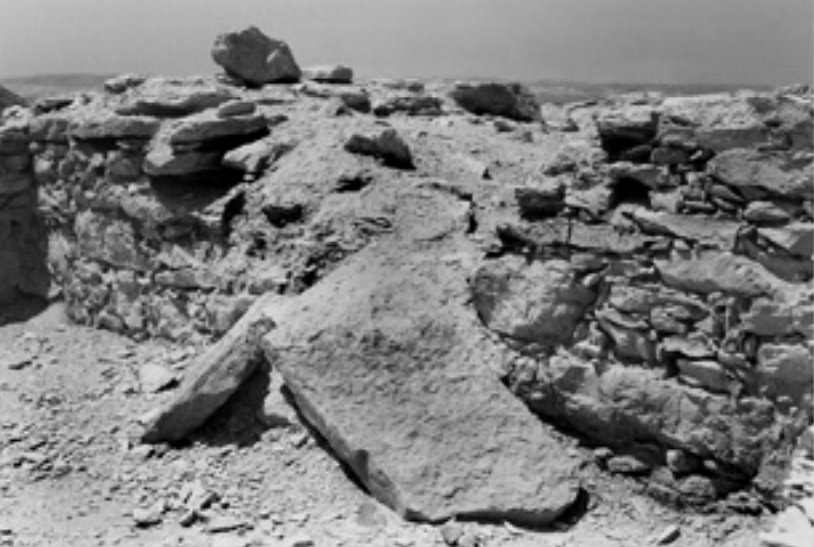
 Figure 10a
Figure 10aEin Rahel Southward collapse of door lintel of EW-oriented wall. Korzhenkov and Erickson-Gini (2003) 
 Figure 10b
Figure 10bEin Rahel Schematic picture of Southward collapse of door lintel of EW-oriented wall. Korzhenkov and Erickson-Gini (2003) |
Collapsed door lintels found in the ruins of the Ein Rahel fort exhibited an oriented collapse. The seismic wave approaching the lintel perpendicular to its orientation caused an oriented collapse which can be recognized by a significant shift of the collapsed lintel on the ground in relation to its original position (Fig.9. 10). Thus the lintel above the entrance to Room 10 (see Fig.5) was thrown eastwards (Fig.9). The door lintel located between Rooms 20 and 9 was thrown southwards (Fig.10) and was broke upon impact. These observations would indicate that the propagation of the seismic waves causing the destruction was from the SE.- Korzhenkov and Erickson-Gini (2003) |
| Collapsed Walls | Upper floor
 Figure 5
Figure 5Ein Rahel Plan of the fort with marked types of deformations. Following Shamir (1999) Korzhenkov and Erickson-Gini (2003) |
Throughout the fort two occupational strata were observed, the earlier from the 3rd to late 2nd cent. B.C. and the later from the 1st cent. to early 2nd cent. A.D. In the surrounding casemate rooms the latest occupational phase (dating to the early 2nd cent. A.D.) was sealed by the collapse of the upper floor of the fort.- Korzhenkov and Erickson-Gini (2003) |
|
| Roof and ceiling collapse | Upper (roof) and Lower (ceiling) floors
 Figure 5
Figure 5Ein Rahel Plan of the fort with marked types of deformations. Following Shamir (1999) Korzhenkov and Erickson-Gini (2003) |
Throughout the fort two occupational strata were observed, the earlier from the 3rd to late 2nd cent. B.C. and the later from the 1st cent. to early 2nd cent. A.D. In the surrounding casemate rooms the latest occupational phase (dating to the early 2nd cent. A.D.) was sealed by the collapse of the upper floor of the fort. Sections excavated in these rooms revealed clear collapse of the ceiling of the lower floor and the upper floor debris sealed by the upper floor roof. The ceiling and roof of the structure were made from woven organic matting and mud and were supported by wooden beams.- Korzhenkov and Erickson-Gini (2003) |
- Modified by JW from Fig. 5 of Korzhenkov and Erickson-Gini (2003)
 Deformation Map
Deformation MapModified by JW from Fig. 5 of Korzhenkov and Erickson-Gini (2003)
- Fig. 5 - Plan of the Fort
with marked types of deformations from Korzhenkov and Erickson-Gini (2003)

 Figure 5
Figure 5
Ein Rahel
Plan of the fort with marked types of deformations.
Following Shamir (1999)
Korzhenkov and Erickson-Gini (2003) - Fig. 8 - Eastward tilt of eastern external wall
from Korzhenkov and Erickson-Gini (2003)

 Figure 8
Figure 8
Ein Rahel
Eastward tilt of eastern external wall. Strike azimuth of the wall is 16°
Korzhenkov and Erickson-Gini (2003) - Fig. 9 - Oriented collapse of door lintel
from N-S wall from Korzhenkov and Erickson-Gini (2003)

 Figure 9
Figure 9
Ein Rahel
- Oriented collapse of door lintel for NS trending wall (strike azimuth is 16°–18°)
- Schematic picture
Korzhenkov and Erickson-Gini (2003) - Fig. 10 - Oriented collapse of door lintel
from E-W wall from Korzhenkov and Erickson-Gini (2003)
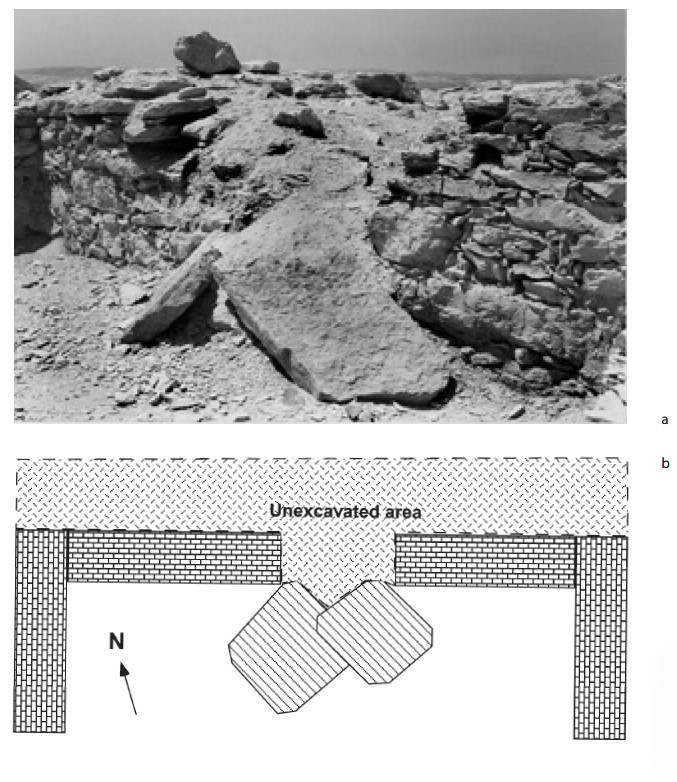
 Figure 10
Figure 10
Ein Rahel
a Southward collapse of door lintel of EW oriented wall
b Schematic picture
Korzhenkov and Erickson-Gini (2003)
Studies of destruction in Ein Rahel fort also reveal a systematic nature of dislocations (see Fig.5):
- NS-trending walls revealed tilt (see Fig. 8) and collapse toward east, whereas perpendicular trending walls tilted and failed down without a noticeable systematic pattern. These observations indicate that the seismic shock arrived approximately along the east-west axis, most probably from the east.
- The door lintel on the N-S trending wall was thrown eastward (see Fig. 9), but the lintel on the E-W trending wall was thrown southward (see Fig. 10). This fact indicates that the propagation of the seismic energy was along the SE-NW axis, making it likely that the seismic waves came from the SE direction.
-
Earthquake Archeological Effects chart
of Rodríguez-Pascua et al (2013: 221-224)

 Earthquake Archeological Effects (EAE)
Earthquake Archeological Effects (EAE)
Rodríguez-Pascua et al (2013: 221-224)
| Seismic Effect | Plan | Figure(s) | Comments | Intensity |
|---|---|---|---|---|
| Tilted Walls | Rooms 9, 11, 12, and 13
 Figure 5
Figure 5Ein Rahel Plan of the fort with marked types of deformations. Following Shamir (1999) Korzhenkov and Erickson-Gini (2003) |
8

 Figure 8
Figure 8Ein Rahel Eastward tilt of eastern external wall. Strike azimuth of the wall is 16° Korzhenkov and Erickson-Gini (2003) |
Earthquake events that have occurred in other parts of the world have produced a large number of structural elements that were found to be preferentially inclined toward the epicenter. However, in some cases the inclination was in the opposing direction. Similar destruction features were found in the ancient fort at Ein Rahel where preferentially inclined walls were observed (see Fig. 5 - Plan).- Korzhenkov and Erickson-Gini (2003) |
VI + |
| Oriented collapse of door lintels - Collapsed Walls Eastward in Room 10 Southward in Room 20 |
Rooms 10 and 20
 Figure 5
Figure 5Ein Rahel Plan of the fort with marked types of deformations. Following Shamir (1999) Korzhenkov and Erickson-Gini (2003) |
9a
 Figure 9a
Figure 9aEin Rahel Oriented collapse of door lintel for NS- trending wall (strike azimuth is 16°–18°) Korzhenkov and Erickson-Gini (2003) 9b 
 Figure 9a
Figure 9aEin Rahel Schematic picture of Oriented collapse of door lintel Korzhenkov and Erickson-Gini (2003) 
 Figure 10a
Figure 10aEin Rahel Southward collapse of door lintel of EW-oriented wall. Korzhenkov and Erickson-Gini (2003) 
 Figure 10b
Figure 10bEin Rahel Schematic picture of Southward collapse of door lintel of EW-oriented wall. Korzhenkov and Erickson-Gini (2003) |
Collapsed door lintels found in the ruins of the Ein Rahel fort exhibited an oriented collapse. The seismic wave approaching the lintel perpendicular to its orientation caused an oriented collapse which can be recognized by a significant shift of the collapsed lintel on the ground in relation to its original position (Fig.9. 10). Thus the lintel above the entrance to Room 10 (see Fig.5) was thrown eastwards (Fig.9). The door lintel located between Rooms 20 and 9 was thrown southwards (Fig.10) and was broke upon impact. These observations would indicate that the propagation of the seismic waves causing the destruction was from the SE.- Korzhenkov and Erickson-Gini (2003) |
VIII + |
| Collapsed Walls | Upper floor
 Figure 5
Figure 5Ein Rahel Plan of the fort with marked types of deformations. Following Shamir (1999) Korzhenkov and Erickson-Gini (2003) |
Throughout the fort two occupational strata were observed, the earlier from the 3rd to late 2nd cent. B.C. and the later from the 1st cent. to early 2nd cent. A.D. In the surrounding casemate rooms the latest occupational phase (dating to the early 2nd cent. A.D.) was sealed by the collapse of the upper floor of the fort.- Korzhenkov and Erickson-Gini (2003) |
VIII + | |
| Roof and ceiling collapse - Displaced Walls | Upper (roof) and Lower (ceiling) floors
 Figure 5
Figure 5Ein Rahel Plan of the fort with marked types of deformations. Following Shamir (1999) Korzhenkov and Erickson-Gini (2003) |
Throughout the fort two occupational strata were observed, the earlier from the 3rd to late 2nd cent. B.C. and the later from the 1st cent. to early 2nd cent. A.D. In the surrounding casemate rooms the latest occupational phase (dating to the early 2nd cent. A.D.) was sealed by the collapse of the upper floor of the fort. Sections excavated in these rooms revealed clear collapse of the ceiling of the lower floor and the upper floor debris sealed by the upper floor roof. The ceiling and roof of the structure were made from woven organic matting and mud and were supported by wooden beams.- Korzhenkov and Erickson-Gini (2003) |
VII + |
Korzhenkov and Erickson-Gini (2003) hypothesize that the epicenter of the causative earthquake was located in the vicinity of the site either to the WNW or ESE (~125 degrees). The proximity of the Arava Fault led them to consider ESE more likely. They estimated a local seismic intensity of VIII–IX.
Carmi, I. and Segal, D. (1995). "Radiocarbon dating of early Islamic textiles in the 'Arava valley." ‘Atiqot (Jerusalem. 1991) 26: 55-56.
Korzhenkov, A. and T. Erickson-Gini (2003). "The Seismic Origin of the Destruction of the Nabataean Forts of Ein Erga and Ein Rahel, Arava Valley, Israel."
Archäologischer Anzeiger: 39-50.
Nahlieli, D. and Israel, Y. (1982) Notes and News: En Rahel Israel Exploration Journal 32 (1982), 163
Shamir, O. (1999). "Textiles, basketry and cordage from En Rahel." ‘Atiqot (Jerusalem. 1991) 38: 91-123.
